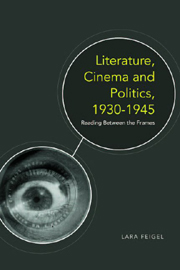Book contents
- Frontmatter
- Contents
- Acknowledgements
- List of Figures
- Introduction
- 1 Radical Cinema
- 2 Mass Observing: The 1930s Documentary Gaze
- 3 The Documentary Movement and Mass Leisure, 1930–1945
- 4 Camera Consciousness
- 5 Framing History: Virginia Woolf and the Politicisation of Aesthetics
- 6 ‘The savage and austere light of a burning world’: The Cinematic Blitz
- Afterword
- Endnotes
- Bibliography
- Index
4 - Camera Consciousness
Published online by Cambridge University Press: 12 September 2012
- Frontmatter
- Contents
- Acknowledgements
- List of Figures
- Introduction
- 1 Radical Cinema
- 2 Mass Observing: The 1930s Documentary Gaze
- 3 The Documentary Movement and Mass Leisure, 1930–1945
- 4 Camera Consciousness
- 5 Framing History: Virginia Woolf and the Politicisation of Aesthetics
- 6 ‘The savage and austere light of a burning world’: The Cinematic Blitz
- Afterword
- Endnotes
- Bibliography
- Index
Summary
If the world itself is cinematic, its inhabitants must play their part in creating as well as viewing cinema. Having accepted the cinematic quality of their surroundings, several 1930s writers figured consciousness itself as a camera or projector. These narratives take the cinematic as read and investigate the experience of living in a world whose subjects are absent actors mediated by the cinema screen. This is the darker side of 1930s cinematic writing; it is hard to be hopeful when you are not sure if you exist at all. It also offers a subjective alternative to the objectivity aspired to by documentary literature and film.
Isherwood would later gloss his infamous ‘I am a camera’ declaration in terms of feeling like a camera, rather than attaining a camera-like objectivity:
what I really meant by saying ‘I am a camera’ was not I am a camera all the time, and that I'm like a camera. It was: I'm in the strangest mood at this particular moment … I just sit and register impressions through the window – visual data – without any reaction to it, like a camera. The idea that I was a person divorced from what was going on around me is quite false.
Camera consciousness here involves a subjective experience of passive, mechanised vision; Isherwood is more victim than witness. According to Stanley Cavell, cinema entered a world ‘whose ways of looking at itself … had already changed, as if in preparation for the screening and viewing of film’.
- Type
- Chapter
- Information
- Literature Cinema and Politics 1930–1945Reading Between the Frames, pp. 122 - 154Publisher: Edinburgh University PressPrint publication year: 2010



